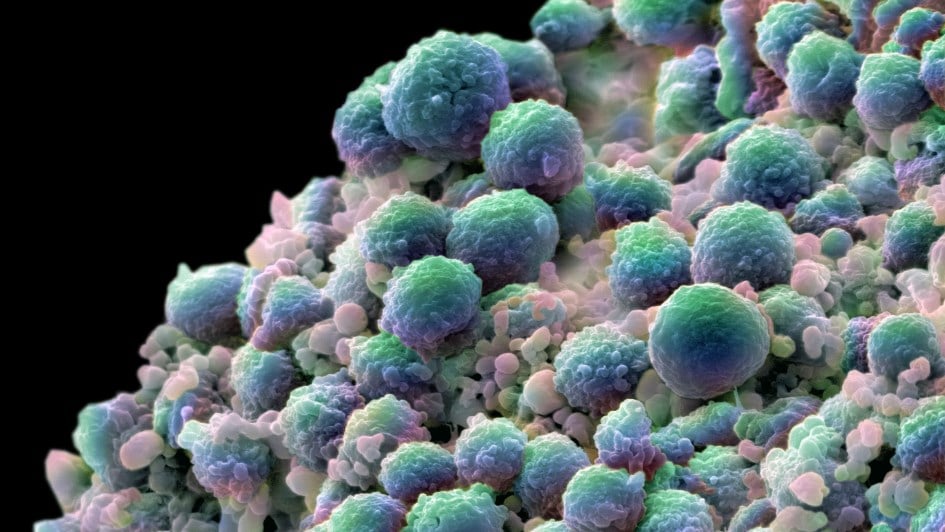
Image: A colour-enhanced image showing a clump of prostate cancer cells. Credit: Annie Cavanagh. CC BY-NC 4.0
Men with ‘high risk’ prostate cancer can safely receive high-dose radiotherapy to kill cancer cells that have spread into neighbouring lymph nodes, a new study reports.
Radiotherapy can often cure patients while cancer cells are still localised to the tumour, and researchers are now eager to see whether it can also have benefits in the early stages of a cancer’s spread.
When prostate cancer advances often the first place it spreads is to the pelvic lymph nodes – but radiotherapy to that area can result in unpleasant side-effects for the patient, such as bowel and bladder problems.
However, the new research found that men who received sophisticated ‘intensity-modulated’ radiotherapy (IMRT) to their lymph nodes had equally low levels of side-effects as men who only received radiotherapy to their prostate.
The phase II clinical trial was led by a team at The Institute of Cancer Research, London, and The Royal Marsden NHS Foundation Trust, and involved multiple centres around the UK where IMRT can now also be delivered.
The new study was published in the International Journal of Radiation Oncology, Biology, Physics, and was funded by Cancer Research UK.
Extending lives of men with prostate cancer
The new findings are a key first step in assessing whether radiotherapy can extend the lives of men with prostate cancer even when the disease has started to spread.
IMRT – a technique pioneered by The Institute of Cancer Research (ICR) and The Royal Marsden – delivers precise doses of radiation shaped to patients' tumours, resulting in less damage to healthy tissue, and allowing higher intensities of radiation to be concentrated on the tumour.
Trials are currently under way to assess whether IMRT to the pelvic lymph nodes can significantly extend the survival of patients diagnosed with prostate cancer at high risk of spreading.
The 124 participants of the trial who had locally advanced prostate cancer were assigned to receive either prostate and lymph node radiotherapy or prostate alone, and included assessment by both doctors and patients reporting their own experience of the treatment.
Both treatment groups received 74 Gy of radiation in 37 fractions to the prostate, with one group receiving 60 Gy in 37 fractions to the pelvic lymph nodes.
Pelvic lymph node IMRT would be deemed safe in the trial if 18 weeks from the start of radiotherapy and less than 20 per cent of patients experienced side-effects grade 2 or higher – symptoms which required treatment.
Six weeks after starting radiotherapy 26 per cent of patients given pelvic lymph node radiotherapy experienced grade 2 or greater side effects compared with 7 per cent of men given prostate radiotherapy alone. However, by week 18 the side effects were reduced.
Five per cent of patients who had their prostate and pelvic lymph nodes treated with this advanced type of radiotherapy experienced grade 2 or greater side-effects compared with three per cent of men who only had their prostate treated.
There was also no difference in side-effects experienced in the subsequent two years of follow-up after receiving IMRT, and there was no difference in patient reported quality of life between the two treatment groups at 18 weeks or two years post treatment.
The ICR Clinical Trials and Statistics Unit (ICR-CTSU) leads the design, conduct and analysis of phase II and III national and international cancer clinical trials. Our findings directly influence clinical practice within the NHS and worldwide.
Read more
Next step: show this can improve survival
Professor David Dearnaley, Professor of Uro-Oncology at The Institute of Cancer Research, London, and Consultant Clinical Oncologist at The Royal Marsden NHS Foundation Trust, said:
“Radiotherapy to the pelvic lymph nodes using traditional methods can often result in unpleasant side-effects for the patient in the form of bladder and bowel problems.
“We have shown that intensity-modulated radiotherapy is a smarter, kinder treatment for locally advanced prostate cancer that can be administered to the pelvic lymph nodes as well as the prostate without having a detrimental impact on a patient’s quality of life. This type of radiotherapy can now be delivered at centres around the country and would be feasible as standard treatment on the NHS.
“The next step for this treatment regime is to show it can improve survival, and trials to assess this are under way.”
Targeting doses to tumours more accurately
Professor Emma Hall, Deputy Director of the Cancer Research UK-funded Clinical Trials and Statistics Unit at The Institute of Cancer Research, London, said:
“Radiotherapy technology has developed over recent years, meaning we can target doses to tumours more accurately and reduce the dose to surrounding tissue.
“This is the first randomised controlled trial designed to assess whether or not modern radiotherapy methods can deliver a high dose to the pelvic lymph nodes without causing the patient to suffer toxic side-effects.
“It’s encouraging that this treatment can be offered without adversely affecting patients’ quality of life, and we’re now eager to see whether it can also have survival benefits for men whose cancer has started to spread.”